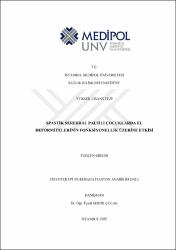Spastik serebral palsili çocuklarda el deformitelerinin fonksiyonellik üzerine etkisi
Künye
Girgin, T. (2020). Spastik serebral palsili çocuklarda el deformitelerinin fonksiyonellik üzerine etkisi. (Yayınlanmamış yüksek lisans tezi). İstanbul Medipol Üniversitesi Sağlık Bilimleri Enstitüsü, İstanbul.Özet
Çalışmanın amacı el deformitelerinin spastik serebral palsili (SSP) çocuklarda, spastisite seviyesi, kavrama kuvveti ve günlük yaşam aktivitelerindeki fonksiyonellik üzerine etkisini araştırmaktır. Çalışmaya 4-18 yaş aralığında, spastik serebral palsi tanısı almış ve son 6 ay içerisinde cerrahi geçirmemiş 26 çocuk alındı. Olgular bilateral (n=13) ve unilateral (n=13) SSP idi. Değerlendirmeler olguların fizyoterapi seansı gününde, fiziksel ve fonksiyonel olarak iki şekilde yapıldı. Fiziksel değerlendirmede, deformiteleri belirlemek için Zancolli Sınıflaması ve House Başparmak Avuç İçi Sınıflaması, kavrama kuvvetini ölçmek için Jamar® el dinamometresi, spastisite değerlendirmesi için Modifiye Ashworth Skalası (MAS) kullanıldı. Fonksiyonel değerlendirmede, elin nesneleri kullanmadaki beceri seviyesini belirlemek için El Becerileri Sınıflandırma Sistemi (EBSS), günlük yaşamdaki el fonksiyonelliğini belirlemek için Modifiye House Fonksiyonel Sınıflandırma (MHC) sistemi ve Elle İlgili Yetenek Ölçeği ABILHAND-Kids, kaba el becerisini değerlendirmek için Kutu ve Blok Test kullanıldı. Her olgu için ayrı ayrı yapılan değerlendirmeler sonucunda, bilateral olgular çoğunlukla EBSS III. seviye, unilateral olgular ise EBSS I ve II. seviye idi. El bileği ve parmak deformiteleri ile EBSS seviyeleri arasında anlamlı ilişki (p<0,05) bulundu. El deformitelerinin kavrama kuvveti üzerinde istatistiksel (p>0,05) olarak bir etkisi bulunmadı. El deformitelerinin unilateral ve bilateral spastik SSP' li çocuklarda omuz, dirsek ve el bileği eklem spastisitesi üzerinde anlamlı (p<0,05) bir etkisi bulundu. Sonuç olarak SSP' li çocuklarda deformiteler yaygın olarak görülmektedir. Kaslarda görülen anormal tonus değişiklikleri ile deformite seviyesi arasında yakın ilişki vardır. Deformite seviyesi elin fonksiyonelliği üzerinde etkilidir. Deformite seviyesi arttıkça kaba el becerisinde ve günlük yaşam aktivite fonksiyonelliğinde azalma gözlenmektedir. The majority of children with cerebral palsy have upper limb problems that adversely affect life. These problems cause joint deformities over times with disorders such as muscle weakness, movement restrictions and spasticity. The aim of this study was to investigate the effect of hand deformities on spasticity level, grip strength, and daily life activities functionality children with spastic cerebral palsy. 26 children between the ages of 4 and 18 who were diagnosed with spastic cerebral palsy and who did not have surgery in the last 6 months were included in the study. The cases were bilateral (n=13) and unilateral (n=13) SCP. Assessments were made on the physiotherapy session days of the cases, physically and functionally in 2 ways. In the physical assessment was used Zancolli Classification and House Thumb-in-palm Classification to determine deformities, the Jamar hand dynamometer to measure grip strength, Modified Ashworth Scale (MAS) to assessment spasticity. In the functional assessment was used Manuel Ability Classification System (MACS) to determine the skill level of the hand in using objects, Modified House Functional Classification (MHC) system and Hand Related Skill Scale ABILHAND-Kids to determine the hand functionality in daily life, Box and Block Test to assessment gross hand skill. As a result of assessments made for each case, bilateral cases were mostly MACS III level, unilateral cases were MACS I and II levels. There was a significant correlation with the level of MACS and wrist and finger deformities. The hand deformities were no statistically (p>0,05) effect on grip strength. Hand deformities had a significant (p <0.05) effect on shoulder, elbow and wrist joint spasticity in children with unilateral and bilateral spastic SCP. As a result the deformities are common in children with SCP. There was a significant correlation with the abnormal tonus changes in the muscles and the level of deformity. The deformity level has an effect on the functionality of the hand. As the deformity levels increase it is observed that the gross hand skills and daily life activity functionality decrease.
Koleksiyonlar
- Tez Koleksiyonu [1159]


















